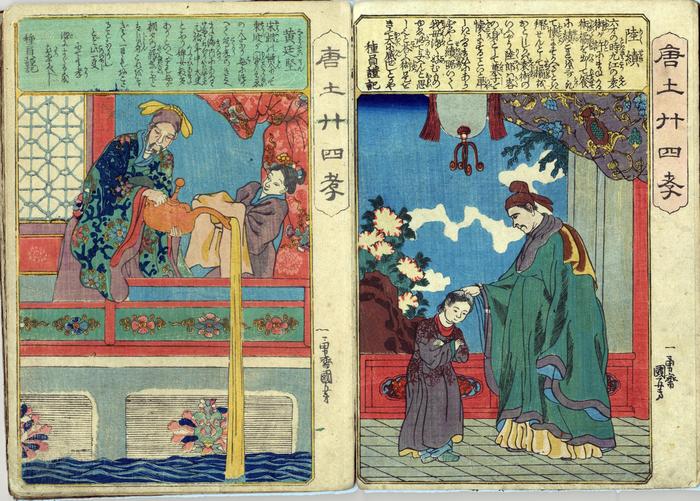Utagawa Kuniyoshi (歌川国芳) (artist 11/15/1797 – 03/05/1861)
Kō Teiken (黄廷堅) and Riku Seki (陸績) from the series The Twenty-four Chinese Paragons of Filial Piety (Morokoshi nijūshi-kō - 唐土廾四孝)
1848
13.5 in x 9.5 in (Overall dimensions) Signed: Ichiyūsai Kuniyoshi ga
一勇斎国芳画
Inscription: Ryūkatei Tanekazu
Kuniyoshi Project
Tokyo Metropolitan Library - right panel
Museum of Fine Arts, Boston - left panel
Tokyo Metropolitan Library - left panel
Museum für angewandte Kunst, Vienna - right panel
Museum für angewandte Kunst, Vienna - left panel
Musées Royaux d'Art et d'Histoire (via Ritsumeikan University) - right panel only - trimmed
Musées Royaux d'Art et d'Histoire (via Ritsumeikan University) - left panel only - trimmed
Art Institute of Chicago - right panel
Art Institute of Chicago - left panel
Nationaal Museum van Wereldculturen (Rijksmuseum Volkenkunde, Leiden) via Ritsumeikan University - right panel only Below is R. Keller Kimbrough's translation of an early edition of the Nijūshikō. It does not specifically apply to these Kuniyoshi prints except in the most general terms.
[23] Sankoku 山谷 (Shangu)
He is known throughout the land,“Sankoku was a poet in the age of Sō 宋. Even now he is regarded as a founding father of poetry. He had many servants, as well as a wife, but he took personal charge of his mother’s chamber pot, washing it with his own hands when it was soiled before returning it to his mother. Morning and evening, he served her well, and he was never remiss. Thus, as we can know a myriad of things from a single example, we can imagine the full extent of his filial deeds. For this reason, his filial piety came to be known throughout the land. Unlike the other people here, this Sankoku is famous.”
and ever filial, he serves his parents.
He scoops from the spring to rinse the chamber pot,
and not because he lacks servant-women.
Kimbrough noted that: "Shangu (Jp. Sankoku) is a pseudonym for the artist, poet, and calligrapher Huang Tingjian 黄庭堅." And: "The age of Sō is the Song 宋 dynasty, 960–1279."
[24] Riku Seki 陸績 (Lu Ji), also known as Kō Ki 公紀 (Gong Ji)
Filial piety and obedience are endowed by nature;When Riku Seki was six years old, he visited a person by the name of En Jutsu 袁術, who put out some mandarin oranges as a refreshment for his guest. Riku Seki took three, placed them in his sleeve, and announced that he was leaving. He bowed to En Jutsu, whereupon the oranges tumbled from his robe. Seeing this, En Jutsu said, “Master Riku Seki, this is unfitting for a child.” Riku Seki replied, “They looked so wonderful that I wanted to go home and give them to my mother.” People say that when he heard this, En Jutsu praised him, declaring, “With his childish heart, to be so very thoughtful! Whether in ancient or modern times, it’s a rarity.” It was because of this, they say, that all under Heaven came to know of his filial piety.
a child, six years among people,
puts oranges in his sleeve to
repay his mother for sweets.
****
The text below was composed by Ryūkatei Tanekazu (柳下亭種員: 1807-58).
The text on the left panel reads: 黄廷堅(くわうていけん) 宋朝(そうのよ)の詩人(しじん)にして東坡(とうば)が門弟(もんてい)高名(かうめい)の人となり母(はゝ)につかへて篤孝(とくかう)のきこへまた海内(くにのなか)にあふるゝ元祐(けんゆう)年中(ねんぢう)大史(おもきやくにん)となり婢女(めしつかひ)数多(あまた)ありといへども母が朝夕の觸器(きたなきもの)などは自身(じしん)これをそゝぎて一日もおこたることなかりしとぞ此一?(このいちじ)にて其孝(かう)他(た)にすぐるを察(さつ)すべし 種員謹記
The book entitled The Twenty-four Paragons of Filial Piety was written by the Chinese scholar Guo Jujing during the Yuan Dynasty. His pen name was Yizi, and he is known in Japan as Kaku Kyokei. The book recounts the self-sacrificing behavior of twenty-four sons and daughters who go to extreme lengths to honor their parents, stepparents, grandparents, and in-laws. Many of the images in this series appear Western in style, rather than Japanese, and were probably copied from Italian prints. The prints in this edition appear to have been printed two per ōban sheet (about 9.5 x 13.5 inches) and folded to chūban pages (about 9.5 x 6.75 inches). The were once bound together in an album.
Japanese name: Kôteiken
Chinese name: Huang T’ing-chien
Kôteiken was a famous Northern Song calligrapher and poet who was so devoted to his mother that he emptied her chamber pot himself.
Robinson: S60.24
Japanese name: Rikuseki
Chinese name: Lu Chi
When Rikuseki was six years old he was invited to the home of a wealthy neighbor where he was given some persimmons, which he slipped into his robes. Upon leaving, the fruit fell out of his robes, and Rikuseki explained that he intended to take them home for his mother. Here Rikuseki is being commended by the wealthy neighbor.
Robinson: S60.19
[The above English-language information is all taken directly from the Kuniyoshi Project.]
The text on the right panel reads: 陸績(りくせき) 六才の時(とき)九江(きうこう)の袁術(えんじゆつ)が許(もと)にまねかる術(じゆつ)橘(たちばな)を出(いた)して餐(もてなす)に績(せき)これを三つ取(とり)て懐(ふところ)にすかへるとき拜(はい)せんとして橘(たちばな)をおとししかば袁術(えんじゆつ)のいふやう陸郎(りくろう)は客(かく)の身(み)として菓子(くわし)を懐(ふところ)にすることいと卑(いや)しきふるまひにあらずやと績(せき)踞(ひざまつ)いて我母(わがはゝ)深(ふか)く好(この)むものゆゑ帰(かへり)て与(あた)へんと思(おもひ)し也と答(こた)ふ術(じゆつ)是をきゝて大(おほい)に感(かん)ぜしとかや 種印謹記
Historical - Social - Ephemera (genre)
Fushimiya Zenroku (伏見屋善六) (publisher)
Ryūkatei Tanekazu (柳下亭種員 - 1807-58) (author)
Nijūshikō (二十四孝: The twenty-four filial exemplars) (genre)
